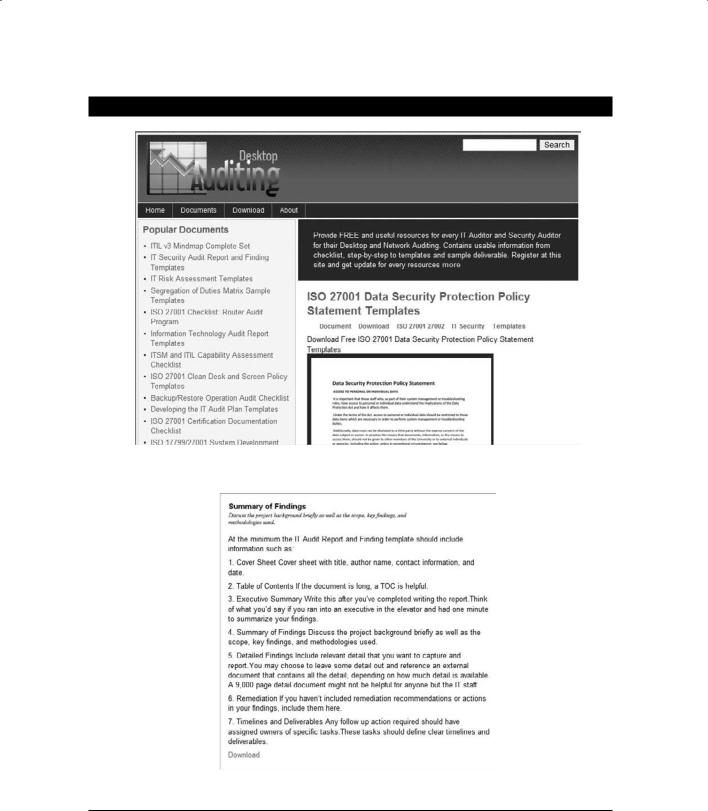
- •Acknowledgments
- •About the Author
- •Contents at a Glance
- •Contents
- •Table of Exercises
- •Introduction
- •Assessment Test
- •Answers to Assessment Test
- •Defining Ethical Hacking
- •How to Be Ethical
- •Keeping It Legal
- •Summary
- •Exam Essentials
- •Review Questions
- •Answers to Review Questions
- •Reconnaissance
- •Information-Gathering Methodology
- •Social Engineering
- •Summary
- •Exam Essentials
- •Review Questions
- •Answers to Review Questions
- •Scanning
- •Enumeration
- •Summary
- •Exam Essentials
- •Review Questions
- •Answers to Review Questions
- •The Simplest Way to Get a Password
- •Types of Passwords
- •Cracking a Password
- •Understanding Keyloggers and Other Spyware Technologies
- •Escalating Privileges
- •Understanding Rootkits
- •Hiding Files
- •Understanding Steganography Technologies
- •Summary
- •Exam Essentials
- •Review Questions
- •Answers to Review Questions
- •Trojans and Backdoors
- •Viruses and Worms
- •Summary
- •Exam Essentials
- •Review Questions
- •Answers to Review Questions
- •How a Sniffer Works
- •Sniffing Countermeasures
- •Bypassing the Limitations of Switches
- •Wireshark Filters
- •Summary
- •Exam Essentials
- •Review Questions
- •Answers to Review Questions
- •Denial of Service
- •Session Hijacking
- •Summary
- •Exam Essentials
- •Review Questions
- •Answers to Review Questions
- •How Web Servers Work
- •Types of Web Server Vulnerabilities
- •Web Application Vulnerabilities
- •Summary
- •Exam Essentials
- •Review Questions
- •Answers to Review Questions
- •SQL Injection
- •Buffer Overflows
- •Summary
- •Exam Essentials
- •Review Questions
- •Answers to Review Questions
- •Wi-Fi and Ethernet
- •Authentication and Cracking Techniques
- •Using Wireless Sniffers to Locate SSIDs
- •MAC Filters and MAC Spoofing
- •Rogue Access Points
- •Wireless Hacking Techniques
- •Securing Wireless Networks
- •Summary
- •Exam Essentials
- •Review Questions
- •Answers to Review Questions
- •Components of Physical Security
- •Understanding Physical Security
- •Physical Site Security Countermeasures
- •What to Do After a Security Breach Occurs
- •Summary
- •Exam Essentials
- •Review Questions
- •Answers to Review Questions
- •Linux Basics
- •Compiling a Linux Kernel
- •GCC Compilation Commands
- •Installing Linux Kernel Modules
- •Linux Hardening Methods
- •Summary
- •Exam Essentials
- •Review Questions
- •Answers to Review Questions
- •Types of IDSs and Evasion Techniques
- •Summary
- •Exam Essentials
- •Review Questions
- •Answers to Review Questions
- •Generating Public and Private Keys
- •Cryptography Algorithms
- •Summary
- •Exam Essentials
- •Review Questions
- •Answers to Review Questions
- •Defining Security Assessments
- •Penetration Testing
- •Pen Test Deliverables
- •Summary
- •Exam Essentials
- •Review Questions
- •Answers to Review Questions
- •Glossary
- •Index

350 Chapter 15 n Performing a Penetration Test
SARA Security Auditor’s Research Assistant (SARA) is a vulnerability assessment tool derived from the System Administrator Tool for Analyzing Networks (SATAN) scanner. Updates are typically released twice a month.
QualysGuard This is a web-based vulnerability scanner. Users can securely access QualysGuard through an easy-to-use web interface. It features more than 5,000 vulnerability checks, as well as an inference-based scanning engine.
SAINT Security Administrator’s Integrated Network Tool (SAINT) is a commercial vulnerability assessment tool.
MBSA Microsoft Baseline Security Analyzer (MBSA) is built on the Windows Update Agent and Microsoft Update infrastructure. It ensures consistency with other Microsoft products and, on average, scans more than 3 million computers each week.
In addition to this list, you should be familiar with the following vulnerability exploitation tools:
Metasploit Framework This is an open source software product used to develop, test, and use exploit code.
Canvas Canvas is a commercial vulnerability exploitation tool. It includes more than 150 exploits.
Pen Test Deliverables
The main deliverable at the end of a penetration test is the pen testing report. The report should include the following:
NN |
A list of your findings, in order of highest risk |
NN |
An analysis of your findings |
NN |
A conclusion or explanation of your findings |
|
|
NN |
Remediation measures for your findings |
NN |
Log files from tools that provide supporting evidence of your findings |
NN |
An executive summary of the organization’s security posture |
|
|
NN |
The name of the tester and the date testing occurred |
NN |
Any positive findings or good security implementations |
E x e r c i s e 15 . 2
Viewing a Sample Pen Testing Report Framework
1.Open a web browser to www.desktopauditing.com.
2.Click the link on the left side for IT Security Audit Report and Findings Template.

Pen Test Deliverables |
351 |
E x e r c i s e 15 . 2 ( c o n t i n u e d )
3.Scroll all the way to the bottom of the page and click the Download link.
4.Use the sample report as a template for creating your own security auditing reports.

352 Chapter 15 n Performing a Penetration Test
Summary
Security auditing or pen testing is a necessary part of running a secure networking environment. It is critical that a trusted and knowledgeable individual such as a CEH test the systems, applications, and components to ensure all security findings can be addressed by the organization. The organization can use the pen testing report as a measure of how successfully they have implemented the security plan and to make improvements on the data security.
Exam Essentials
Be able to define a security assessment. A security assessment is a test that uses hacking tools to determine an organization’s security posture.
Know pen testing deliverables. A pen testing report of the findings of the penetration test should include suggestions to improve security, positive findings, and log files.
Know the legal requirements of a pen test. A pen tester should have the client sign a liability release, a scope of work, and a nondisclosure agreement.
List the penetration testing steps. Preattack, attack, and postattack are the three phases of pen testing.
Know the two types of security assessments. Security assessments can be performed either internally or externally.

Review Questions |
353 |
Review Questions
1.What is the purpose of a pen test?
A.To simulate methods that intruders take to gain escalated privileges
B.To see if you can get confidential network data
C.To test the security posture and policies and procedures of an organization
D.To get passwords
2.Security assessment categories include which of the following? (Choose all that apply.)
A.White-hat assessments
B.Vulnerability assessments
C.Penetration testing
D.Security audits
E.Black-hat assessments
3.What type of testing is the best option for an organization that can benefit from the experience of a security professional?
A.Automated testing tools
B.White-hat and black-hat testing
C.Manual testing
D.Automated testing
4.Which type of audit tests the security implementation and access controls in an organization?
A.A firewall test
B.A penetration test
C.An asset audit
D.A systems audit
5.What is the objective of ethical hacking from the hacker’s prospective?
A.Determine the security posture of the organization
B.Find and penetrate invalid parameters
C.Find and steal available system resources
D.Leave marks on the network to prove they gained access
6.What is the first step of a pen test?
A.Create a map of the network by scanning.
B.Locate the remote access connections to the network.
C.Sign a scope of work, NDA, and liability release document with the client.
D.Perform a physical security audit to ensure the physical site is secure.

354 Chapter 15 n Performing a Penetration Test
7.Which tools are not essential in a pen tester’s toolbox?
A.Password crackers
B.Port scanning tools
C.Vulnerability scanning tools
D.Web testing tools
E.Database assessment tools
F.None of the above
8.What are not the results to be expected from a preattack passive reconnaissance phase? (Choose all that apply.)
A.Directory mapping
B.Competitive intelligence gathering
C.Asset classification
D.Acquiring the target
E.Product/service offerings
F.Executing, implanting, and retracting
G.Social engineering
9.Once the target has been acquired, what is the next step for a company that wants to confirm the vulnerability was exploited? (Choose all that apply.)
A.Use tools that will exploit a vulnerability and leave a mark.
B.Create a report that tells management where the vulnerability exists.
C.Escalate privileges on a vulnerable system.
D.Execute a command on a vulnerable system to communicate to another system on the network and leave a mark.
10.An assessment report for management may include which of the following? (Choose all that apply.)
A.Suggested fixes or corrective measures.
B.Names of persons responsible for security.
C.Extensive step by step countermeasures.
D.Findings of the penetration test.
11.What makes penetration testing different from hacking?
A.The tools in use
B.The location of the attack
C.Permission from the owner
D.Malicious intent

Review Questions |
355 |
12.What documents should be signed prior to beginning a pen test? (Choose two.)
A.Liability release
B.Nondisclosure agreement
C.Hold harmless agreement
D.Contract agreement
13.What is another name for a pen test?
A.Compliance audit
B.Network audit
C.Security audit
D.Validation audit
14.What is the first part of the pen testing report?
A.Findings
B.Remediation
C.Compliance
D.Executive summary
15.What is a type of security assessment in which the test is performed as if the tester were an employee working from within the organization?
A.Internal assessment
B.Black hat testing
C.Full-knowledge test
D.Organization audit
16.Which type of test involves a higher risk of encountering unexpected problems?
A.White-hat test
B.Black-hat test
C.Grey-hat test
D.Internal assessment
17.What is one reason to outsource a pen test?
A.Specific audit requirements
B.Less risky
C.More findings
D.Effective countermeasures
18.In which phase of a pen test is scanning performed?
A.Preattack phase
B.Information gathering phase
C.Attack phase
D.Fingerprinting phase

356 Chapter 15 n Performing a Penetration Test
19.Which component of a pen testing scope of work defines actions to be taken in the event of a serious service disruption?
A.Service requirements
B.Service-level agreement (SLA)
C.Minimum performance levels
D.Failback plan
20.Which automated pen testing tool can identify networked devices on the network, including desktops, servers, routers/switches, firewalls, security devices, and application routers?
A.ISS Internet Scanner
B.Core Impact
C.Retina
D.Nessus
